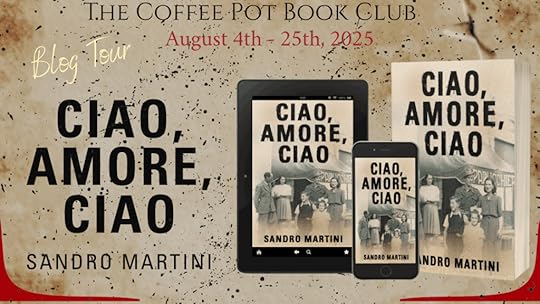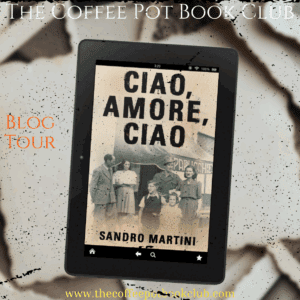Sandro Martini Ciao, Amore, Ciao #CiaoAmoreCiao #HistoricalFiction #WWII #BlogTour #TheCoffeePotBookClub @MartiniAlex @cathiedunn
I’m delighted to welcome Sandro Martini as the featured author in The Coffee Pot Book Club Blog Tour being held between August 4th – 25th, 2025. Sandro Martini is the author of the Historical Fiction, Ciao, Amore, Ciao (Alex Lago Book #1), published by Black Rose Writing on March 26, 2025 [426 pages (kindle); 385 pages (paperback)].
Below are highlights of Ciao, Amore, Ciao, Sandro Martini’s author bio, and a guest post about the historical background of the novel.

Tour Schedule Page: https://thecoffeepotbookclub.blogspot.com/2025/07/blog-tour-ciao-amore-ciao-by-sandro-martini.html
HIGHLIGHTS: CIAO, AMORE, CIAO

Ciao, Amore, Ciao
(Alex Lago Book #1)
By Sandro Martini
Blurb:
An enthralling dual-timeline WWII family mystery, based on the heartbreaking true story of the massacre in a small town in Italy in July of 1945, from award-winning, bestselling novelist Sandro Martini.
“A gripping saga that roots excruciating betrayals in a nation’s tragic history.” –Kirkus Reviews
In the winter of 1942, an Italian army of young men vanishes in the icefields of the Eastern Front. In the summer of 1945, a massacre in Schio, northeastern Italy, where families grieve the dead, makes international headlines.
In present-day Veneto, an ordinary man is about to stumble onto a horrifying secret.
Alex Lago is a jaded journalist whose career is fading as fast as his marriage. When he discovers an aged World War II photo in his dying father’s home, and innocently posts it to a Facebook group, he gets an urgent message: Take it down. NOW.
Alex finds himself digging into a past that needs to stay hidden. What he’s about to uncover is a secret that can topple a political dynasty buried under seventy years of rubble. Suddenly entangled in a deadly legacy, he encounters the one person who can offer him redemption, for an unimaginable price.
Told from three alternating points of view, Martini’s World War II tale of intrigue, war, and heartbreak pulls the Iron Curtain back to reveal a country nursing its wounds after horrific defeat, an army of boys forever frozen at the gates of Stalingrad, British spies scheming to reshape Italy’s future, and the stinging unsolved murder of a partisan hero.
Ciao, Amore, Ciao is a gripping story of the most heroic, untold battle of the Second World War, and a brilliantly woven novel that brings the deceits of the past and the reckoning of the present together.
“Balances action, suspense, and emotional depth to deliver a truly immersive, thought-provoking read with an unflinching look at the sins of the past and the lengths to which the powerful will go to keep them buried.” ~ Sublime Book Review
Any Triggers: War
Buy Link:
Universal Buy Link: https://books2read.com/u/4A6R10
This title is available to read on #KindleUnlimited.
AUTHOR BIO: SANDRO MARTINI

Sandro Martini has worked as a word monkey on three continents. He’s the author of Tracks: Racing the Sun, an award-winning historical novel.
Sandro grew up in Africa to immigrant parents, studied law in Italy, chased literary dreams in London, hustled American dollars in New York City, and is now hiding out in Switzerland, where he moonlights as a Comms guy and tries hard not to speak German.
You can find him either uber-driving his daughter, chasing faster cars on the autobahn, or swimming in Lake Zurich with a cockapoo named Tintin.
His latest historical suspense novel, Ciao, Amore, Ciao, is now available.
Author Links:
Website Twitter / X Facebook Instagram
Book Bub Amazon Author Page Goodreads
GUEST POST: SANDRO MARTINI

Most English-language accounts of Italy in the Second World War stop at Mussolini’s surrender and switch of sides, yet the deeper story— the landscape of my novel Ciao, Amore, Ciao—has rarely been told. Fascism’s roots stretch beyond Rome to post-1918 disillusion: London’s secret promise of Dalmatia to Italy; Italy’s betrayal at Versailles, branded by poet-soldier Gabriele D’Annunzio as the “mutilated victory”; and D’Annunzio’s seizure of Fiume, where fascist symbols, chants, and salutes were first codified.
Paradoxically, fascism’s demise didn’t happen in September 1943 when the Allies made landfall in Sicily. It began nine months earlier, on the Don River, during the Battle of Stalingrad. Mussolini, hoping to share the Baku oilfields with his Nazi chums, had sent more than 250,000 Italians east in 1942, my uncle included. Quickly reassigned to shield the German Sixth Army’s exposed flank as the might of the Nazi war machine stalled at the gates of Stalingrad, Italy’s army met the full force of the Soviet winter counter-offensive. On 26 December 1942, the Red Army smashed through the Italian lines, trapping Italians and Germans alike in what survivors still call “the sack” that doomed both the Sixth Army in Stalingrad and, ultimately, the Axis war itself. In less than a month, the course of the war had changed irreversibly.
What followed the Red Army’s offensive was a 14-day nightmare march for the Italian army. In a frozen landscape where the temperature never rose above -30°C, the Alpine Corps fought a dozen rearguard battles while walking some 250 km toward a new, shaky Axis front. Their final obstacle was the railway hamlet of Nikolayevka, reached on 26 January 1943 and remembered as Italy’s Thermopylae: those who burst through lived; those who did not vanished into the snow. It ended with the last-ever human wave attack in recorded warfare.
The numbers are staggering. Of roughly 230,000 Italian soldiers on the Don, only about 140,000 ever saw home again. Roughly 85,000 died in battle, on the frozen retreat, or in Soviet camps. Of the 60,000 taken prisoner and force-marched to POW camps (the way of the davai), scarcely one in six returned between 1945 and 1954. Among the disappeared was my 19-year-old uncle, Alessandro, whose fate my anti-hero, Alex Lago, strives to uncover in Ciao, Amore, Ciao. Soviet archives opened after 1991 solved thousands of family mysteries, yet his name never surfaced; dog tags still emerge from the same steppe which is today scarred by a new war between Russia and Ukraine. But of my uncle Alessandro’s fate, nothing.
Those who limped back in 1943 were met not with parades but with silence and shame. Fascist propaganda could not admit the annihilation of its elite troops, and within months, many survivors were in the hills with the Russian-armed partisans, battling first the fascists and then, when Italy surrendered in 1943, the Germans who had raced south to occupy their former ally.
Liberation in 1945 ushered in the horror of the “resa dei conti”—the settling of scores. In the Po Valley’s “Triangle of Death”, thousands of fascist collaborators were summarily executed and buried in mass graves, a grisly mirror of the squadristi terror campaigns of the 1920s.
One episode, the July 1945 massacre in Schio in the Veneto, drew the scrutiny of the New York Times and of Allied investigators. With Italy’s Communist Party poised to dominate post-war elections, and Washington and London fearful that an Italian swing to the left might pull France, and perhaps all of Western Europe, behind the Iron Curtain, it suddenly became politically expedient to pin the post-war massacres on Communist partisans. And Schio was their mascot because it was one of only two towns that were liberated not by the Allies but by the partisans themselves. The message the Allies wanted to give was, “Look at what happens when the Communists take over.”
Come 1948 and the first post-war elections, the newly minted CIA would use that massacre in Schio as part of its propaganda campaign to buy its first client state: They’d funnel millions from the Marshall Plan to spread propaganda linking the Italian Communist Party to the post-war massacres in 1945, accuse the communists of wilfully colluding with the Soviets to keep Italian POWs in the USSR, and provide literal “bags of cash” to US-friendly politicians. It worked, and that Italian election became the blueprint for the CIA’s covert proxy wars for decades after.
It’s a rich tapestry for a novel. But the personal is where Ciao, Amore, Ciao is grounded: In my uncle’s fate in Russia, and my dad, who saw the massacre in Schio as a 15-year-old boy. And the scars that would haunt him his whole life. It’s the story of the “little” people trapped in these cold machinations of the powerful, a story of a family of no ones swept away by history, fate, and the limitless supply of human folly.
 Twitter: @cathiedunn
Twitter: @cathiedunn
Instagram & Threads: @thecoffeepotbookclub
Bluesky: @cathiedunn.bsky.social



